
A recipe created with recycled ingredients, now a symbol of Spanish cuisine: it's paella, a tasty specialty that comes in many local variations. Originating from the Valencia community, paella has now spread well beyond the Spanish borders, becoming particularly appreciated in the countries bordering the Mediterranean, in Latin America and even reaching the Philippines, where paelya is cooked, a dish also called arroz a la valenciana.
What is the Original Recipe for Paella and How Was It Born
The origins of this dish are not known with certainty, even if historical documents place its birth in the period between the 15th and 16th centuries. The word paella, which derives from the Latin patella, indicated a large and shallow iron pan, equipped with two opposite handles, which was used in the community of Valencia to cook various dishes made with rice or fedelini, a pasta similar to spaghetti: the preparation, therefore, takes its name from the pot in which it is cooked, whose name later evolved into paellera.
It is known that the recipe is of peasant origin: the workers needed a rich and substantial dish, to take to the fields and to "make it last" throughout the day. The mix of ingredients derives from waste from the noble tables and this also explains the use of saffron, a precious spice that could only be recovered thanks to the leftovers from the kitchens that prepared meals for the nobles.
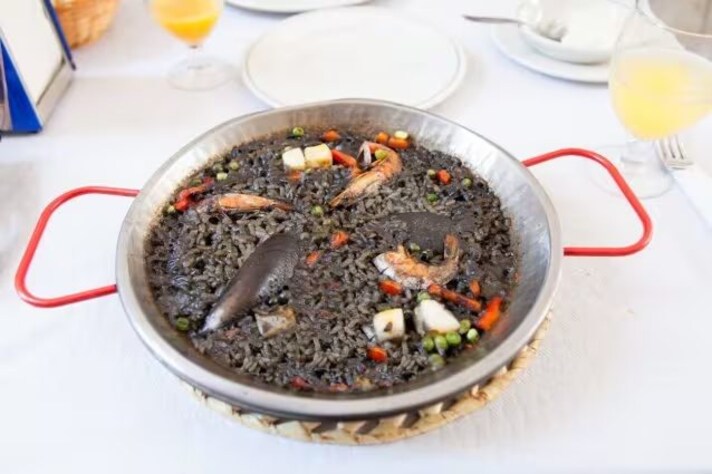
What Type of Rice is Used for Paella?
The Spanish generally use Senia, Bahia or Bomba quality rice, with short or round grains, ideal because they are able to absorb a lot of water while holding up well when cooked. These are varieties belonging to a single type, the Arroz de Valencia Dop, growin in the Albufera Natural Park, near Valencia. The most used variety by far is Bomba rice, because it has slightly stubbier grains than the other two. If you can't find any of these varieties, you can alternatively use Vialone nano, Arborio or Balilla rice.
All Types of Paella: The Most Popular Variations
Paella is very versatile and can be customized depending on the ingredients available: the Valencian version, which should be the "original" one, includes rice, marinated chicken and rabbit meat, green vegetables such as green beans or snow peas, tomatoes, peppers, beans, to which snails and spices, such as saffron and rosemary, are sometimes added. The most widespread variant is Paella de Marisco, or paella made with seafood, which is prepared mainly in areas overlooking the Mediterranean. With the same base of rice and saffron we find variations that include meat and seafood together, in the mixed paella. A particular variant is the one created in Alghero at the beginning of 2000 on the occasion of the celebrations of the 900th anniversary of the city, the Alghero paella, made with a mix of local meats and seafood and fregola instead of rice, also known as paella black or pasta. Here are the main varieties of paella, to try at least once in your life.
1. Paella de Marisco

Paella de Mariscos is one of the most popular variations, based on seafood, prepared especially in coastal areas. The basis of the recipe is always rice and saffron, but the protagonists are mussels, calamari, prawns and scampi: it can also be made with clams, cuttlefish or other types of fish depending on what the market offers. The sice is mixed with fish stock and garlic, onions, sweet paprika, chili pepper and tomato puree are also added to the recipe. A real treat perfect for summer.
2. Valencian Paella
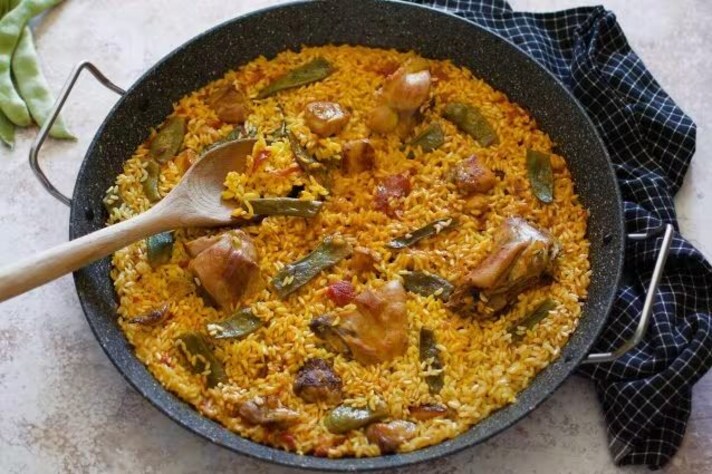
It is probably the oldest version of paella, made with rice, saffron, chicken, rabbit and vegetables, especially green beans, peppers and tomatoes. In some variations, land snails, beans, peas, broad beans, artichokes and duck are also added. To wet the rice, add the hot meat broth to it: once cooked, transfer it to the oven for a few minutes, so that it forms a light and irresistible external crust.
3. Mixed Paella
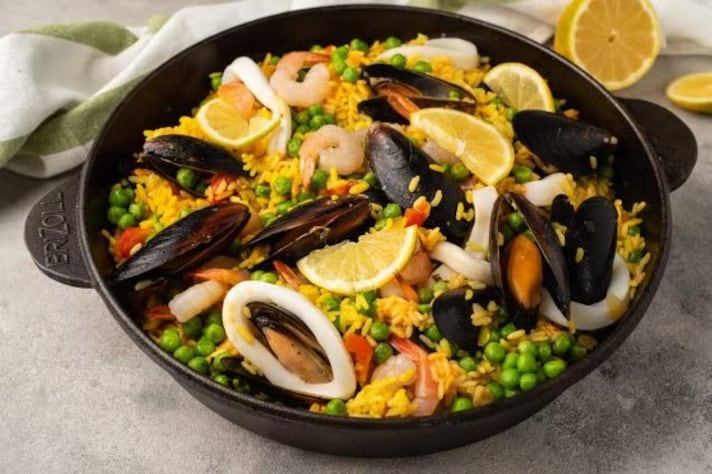
Mixed paella can be made in many ways: this version that we present to you is the "Catalan" variant, which includes both chicken meat, prawns, calamari and mussels, but also vegetables such as peppers, peas, onions. In reality this recipe includes many reworks, in which there are also eggplants, zucchini, in the summer season, or potatoes and mushrooms in the winter season.
4. Alghero Paella

The most recent variant of paella, created to celebrate the centenary of the foundation of the city of Alghero and its links with the Spanish heritage. Alghero paella includes fregola, a typical Sardinian format made with durum wheat flour, instead of rice, which is combined with local ingredients, such as mussels, shellfish, chicken, sausage and vegetables.
5. Black Paella
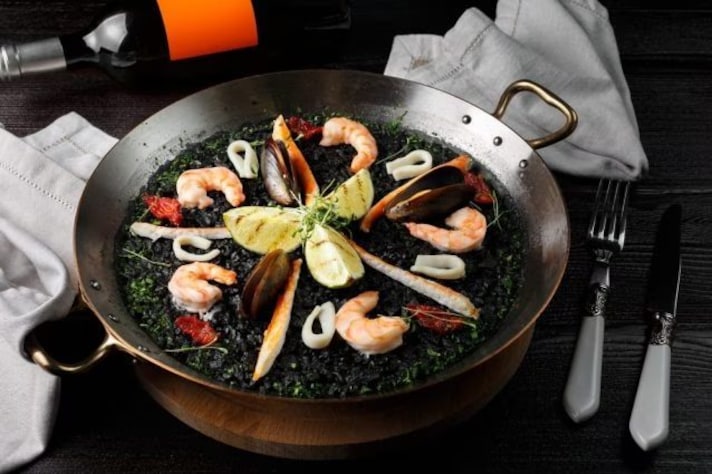
A very particular version is the paella negra, or arroz negro: it derives from the mixed paella and is widespread especially in the coastal areas of the Valencian Community and Catalonia. Saffron is not used to season the rice, but cuttlefish ink, which makes the dish truly spectacular: in the basic version only cuttlefish is used, but sometimes it can be enriched with mussels, prawns, squid and calamari. It is sometimes accompanied by aioli sauce, a practically omnipresent condiment in Spain.
6. Paella or Fideuà
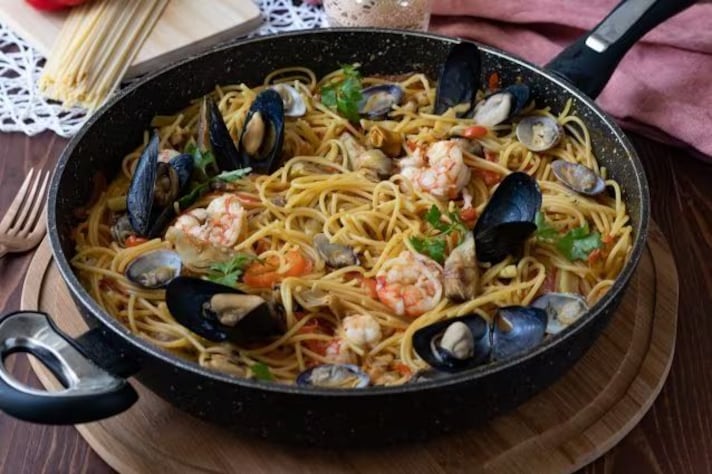
It is probably the version that differs the most from the classic paella, because it replaces the main element: rice, as in the Alghero paella. In fideuà, in fact, pasta is used, to be precise fideos: a pasta with a round and thin section, similar to spaghetti, but shorter. It is seasoned with, especially monkfish, but also molluscs and crustaceans such as mussels, prawns, cuttlefish, squid and vegetables. It is especially typical of the area called La Safor, which is part of the Valencian Community, and since 1974 it has been celebrated in an international festival.
;Resize,width=767;)
